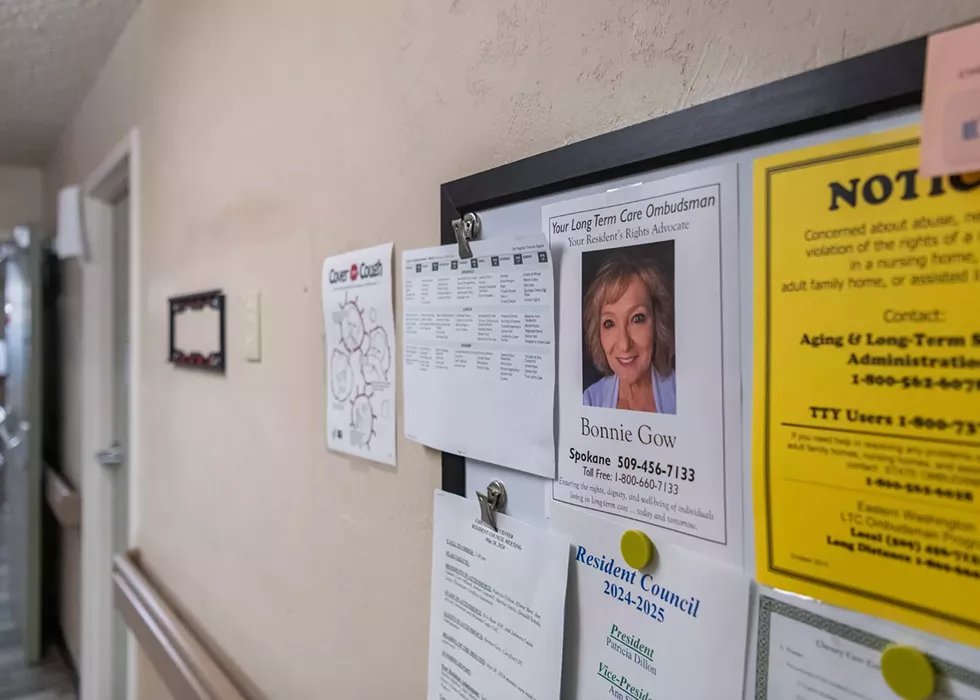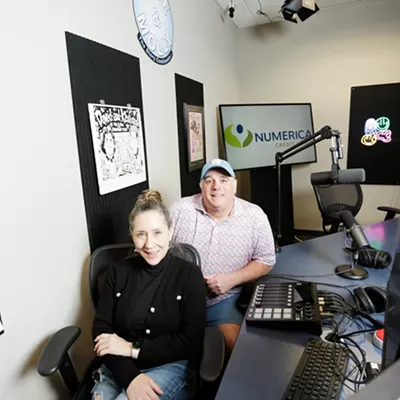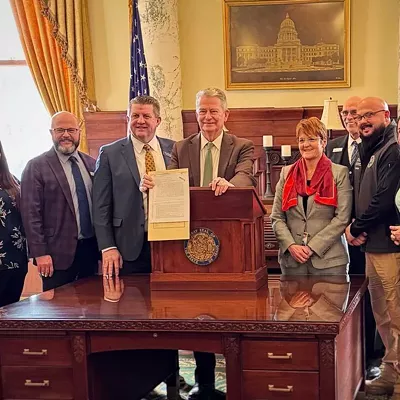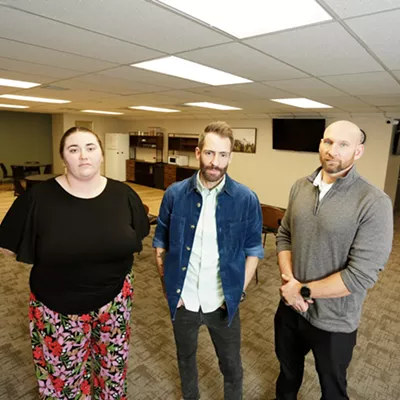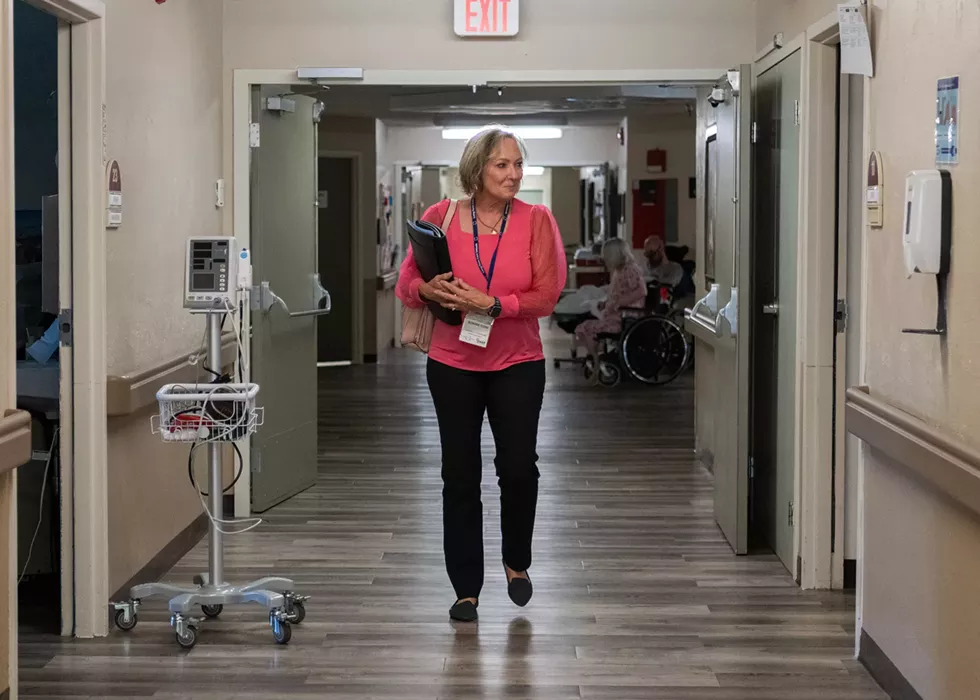
On a white-hot Wednesday afternoon in mid-August, Bonnie Gow wanders the air-conditioned halls of the Cheney Care Community's nursing home. She's not a resident or member of the facility's staff, but a volunteer long-term care ombudsman working to ensure residents are being properly cared for.
She walks at a steady pace down the hall, leaving enough time to read the name cards on each door she passes until she stops at the room of Michael Walsh. Gow knocks three times and waits for a muffled response through the door before she enters.
Moments later she retrieves a nurse to prop up Walsh, a resident with quadriplegia, so he can be comfortable while the two chat. Walsh doesn't have any issues he needs Gow's assistance with today, so they spend time catching up instead. In one moment Walsh tells her about the shows he's watching (The Umbrella Academy and Schitt's Creek), while in the next he's reflecting on what Gow's presence over the past two years has meant to him.
"Ever since I've been here and met Bonnie, my life has gotten better," Walsh says. "When I talk to her, things get done."
For example, when he was unable to press a call button to get the attention of the staff, she worked with the facility's administrator to install a call button he can activate by breathing into a strawlike device.
This basic kind of advocacy hasn't always been offered to Walsh, who says he's been in nursing homes for almost a decade. A few years ago, at another facility, he suffered from a pressure ulcer — also known as a bedsore — on his back that was not treated properly by staff. Due to further neglect, Walsh says the ulcer got so bad it nearly killed him.
Had there been a volunteer ombudsman like Gow regularly visiting that facility, he says, they could have ensured that Walsh was being moved around throughout the day or even being bathed regularly — ultimately, preventing a near-death experience. As it was, Walsh says he was hospitalized in a wound-care unit for 16 months before he was able to move into the facility in Cheney.
Walsh's story of neglect isn't an uncommon one. Many residents in long-term care facilities have no friends or family to check in on them. According to the National Center for Health Statistics, an estimated 60% of long-term care residents nationwide don't receive regular visits.
As the only independent check-and-balance system for these facilities in the state, that's where the long-term care ombudsman program is supposed to come in. But currently, there are only 24 volunteers to check on more than 1,000 long-term care facilities in Eastern Washington.
Most of these volunteer ombuds are retirees spending a handful of hours each week checking on residents at one or two facilities they oversee. The shortage in volunteers has left the region's ombuds unable to regularly check on every facility to ensure that residents are being properly cared for.
WHAT'S AN OMBUDSMAN?
Most residents in long-term care facilities — which include nursing homes, assisted living facilities, adult family homes and any similar residential care facility — have no idea what services they're legally entitled to or even what an ombudsman is, Gow says.Before she became a volunteer ombudsman, Gow says she also didn't know the program existed, but after watching her mother suffer in care facilities that prescribed the wrong medication and didn't provide adequate bathing or eating assistance, she wishes she did.
Long-term care ombudsman programs have been federally mandated in each state since the 1970s. Prior to that, Congress passed the Older Americans Act (OAA) in 1965, which was the first national initiative meant to provide funding for the comprehensive care of older and aging Americans.
As amended in the '70s, the OAA requires each ombudsman program to: identify, investigate and resolve resident complaints; provide residents with information about long-term services and supports; ensure that residents have regular and timely access to ombudsman services; represent the interests of residents before governmental agencies; seek administrative, legal and other remedies to protect residents; and analyze and recommend changes in laws and regulations pertaining to residents' rights.
TERMS OF THE TRADE
Adult family homes: These facilities are about as close to living at home as long-term care residents can get. Adult family homes are only licensed for six residents at a time, setting them apart from assisted living facilities, even though the two provide similar levels of care.
"[Long-term care ombuds] have no actual enforcement authority. We don't issue fines. We don't do what the state would do for people who violate the regulations," says Richard Danford, the regional ombuds for Eastern Washington. "Our goal is to represent the residents and their family members in advocating for services that they need and addressing problems and complaints with the services they are being provided."
As the regional ombudsman, Danford is paid to oversee the activity and training of volunteer ombuds in Eastern Washington.
While federal law requires ombudsman programs, it allows states to decide how to run them.
In Washington, the long-term care ombudsman program is comprised of 13 regional entities that partner with nonprofits, and the program is independent of the Washington Department of Social and Health Services (DSHS). DSHS oversees long-term care in the state, setting the regulations for how care facilities must be run and handling official complaints and enforcement actions.
Overall, there are about 25 full-time employees between the ombudsman staff at the state level and the program's 13 regional entities, according to a 2023 annual report. The Eastern Washington region, which encompasses Spokane, Whitman, Pend Oreille, Stevens and Ferry counties, has 2.5 of those staffers, including Danford.
Operating the program independently of any state agency makes it easier for an ombudsman to advocate for residents, Danford says.
"Just having an ombudsman's presence in a facility makes a huge difference."
"You can't really be an advocate unless you are independent," he says, noting he had different experiences as a long-term care ombudsman in New York, where the program is housed within the New York State Office for the Aging.
While Washington's long-term care ombudsman program is one of the few in the nation to be fully independent, it struggles to meet the demand due to its volunteer-based model, Danford says.
Since residents are entitled to "regular and routine visits," Danford says he'd actually need more than 100 volunteers to feel like his region was fully covered — right now they've got fewer than 30 volunteers.
He says the volunteer model has been "undeniably proven to be inadequate."
"Our volunteers are wonderful, but we need lots and lots more," Danford says. "It's just not the right model."
Idaho's long-term care ombudsman program operates similarly, but its staffing structure is different. Instead of working entirely independently, Idaho's program falls under the Idaho Commission on Aging — a state department that oversees long-term care in the state — but maintains independent authority to carry out its work.
Idaho's State Long-Term Care Ombudsman Fanny Rodriguez-Melnikovsky says their program is supplemented by volunteers, rather than nearly all volunteer-based as Washington's is.
"We have hired full-time ombudsmen in each area — Coeur d'Alene, Lewiston, Pocatello, Idaho Falls, Boise and Twin Falls — and we feel that we're pretty close to staffing needs," she says.
PROGRAM IN NEED
Washington's population of older adults is growing each year, and there's no sign it'll slow down anytime soon. As of 2022, 23% of the state's adult population was age 60 or older, according to the DSHS "State Plan on Aging." That's 1.8 million Washingtonians who are eligible for Older Americans Act programs, such as home-delivered meals, transportation assistance and in-home caregiving. By 2050, it's expected that nearly a third of the state's adult population will be in that age range.Much of the country is forecasting similar growth in its elderly population. That worries Danford, who says that Eastern Washington's ombuds already can only ensure regular visits at about 60% of the region's long-term care facilities. Without more volunteers (or a change in the model), it may get even harder to catch issues with inadequate or neglectful care as the state's population gets older.
"There's a huge population of folks that we aren't reaching or who don't even know about our services right now," Danford says. "When you weigh that against the kinds of issues that we are coming across in those facilities we are covering, it automatically causes a great deal of concern, because they're not all just complaints about the food. Conditions aren't the greatest, so when you think about the 30% to 40% of [residents] not having access to our services, it's just unacceptable."
Washington's long-term care ombudsman program receives thousands of complaints each year, according to its annual report. In 2013, the state's 347 volunteer ombuds received 4,835 complaints. A decade later, the number of volunteers and complaints fielded were both down, with only 154 volunteers statewide receiving 2,765 complaints in 2023. Each year, the state's volunteers close about half of the complaint cases they receive.
While the quantity of complaints and pool of those responsible for responding has shrunk, the types of complaints that residents made were unchanged. The most common complaint over the past 10 years was about facilities discharging or evicting residents. Lack of proper care, staff attitudes and food were also common complaints.
While the ombudsman program in Washington advocates for residents, and can ask staff at their facility to address any issues, DSHS has direct oversight and the authoritative regulatory power over care facilities.
Unlike the state ombudsman program that requires volunteers to visit each of the state's facilities quarterly (volunteer ombudsman Gow often visits her facilities weekly), DSHS staff are required to visit nursing homes only once every nine to 15 months and to visit all other residential care programs every 12 to 18 months.
"Our complaint system is separate from our required visits," says Amy Abbott, director of residential care services at DSHS. "We don't wait until [required] visits to deal with resident complaints. We're always going out to these facilities."
Each year the state agency receives more than 10,000 complaints, Abbott says. Those complaints are triaged based on severity. Immediate concerns, such as complaints of abuse or severe health problems, are often responded to within a couple of days. Some complaints where there is a potential for harm, but it's not an immediate threat, are responded to within a week. Abbot says this second category can include situations where there's been an altercation between a resident and staff, but the aggressor has already been removed from the facility. Many common complaints about food or staff attitudes are sorted into a third category that requires a visit within a month.
While DSHS is separate from the state ombudsman program, the two entities work in tandem to ensure that all residents are having their needs met and their rights respected.
"Ideally, we would like to see residents in facilities working with the ombuds, which is often the lowest level of mediation, so they can mediate to find a solution," Abbott explains. "[The ombudsman] can always ask a resident to file a complaint and then we can get in there to regulate."
MAKING AN IMPACT
"Just having an ombudsman's presence in a facility makes a huge difference," Gow says.That's been the case in the facility that she checks on. Since Gow began her volunteer work at the Cheney Care Community two years ago, the number of complaints from residents has shrunk, the facility's Executive Director Ashley Healey says.
While Healey has been in charge for about two years, she's been working as a licensed practical nurse there since 2016. Before Gow began visiting in 2022, Healey says an ombudsman was a rare sighting.
"The fact that we have an active ombudsman is so unique, and I think it's made our care better," Healey says.
If staff are the issue, residents might be afraid to speak up to other staff, she says. "Just having someone here once a week that they can talk to has been great."
Gow assuages any resident concerns about retaliation by serving as a sort of arbitrator. With the explicit consent of the resident or their family, she has the ability to file complaints with DSHS, but she isn't required to. More often than not, she'll work to fix the issue herself.
When Charlie Meye, a Cheney Care Community resident, told Gow that he probably needed to be on antidepressants, he says she promptly worked with the facility's staff to get him a prescription. And when Walsh, the resident with quadriplegia, had trouble using the remote for his TV because he's unable to use his arms or legs, Gow was able to help set up voice-activated controls.
"I work closely with the administrator of the facility to address any issues at the lowest level possible," Gow says. "Instead of filing a formal complaint with a state department and waiting for it to be addressed, I can just talk to [Healey] about the residents' complaints."
Other issues take more time to address, such as the constant complaints she hears about the facility's food. Although Gow doesn't yet have any concrete answers for the residents who bring it up, she calmly updates them that she's still working for some improvement.
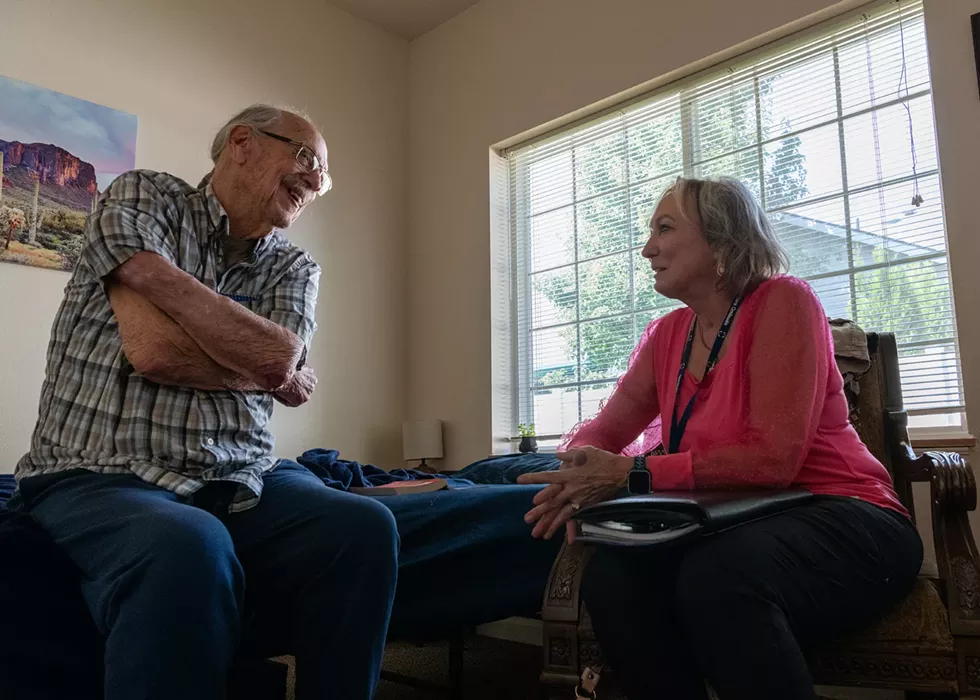
IT'S PERSONAL
Gow's work as a long-term care ombudsman is important to her because she's seen firsthand what happens when that oversight is missing. Her mother was diagnosed with Lewy body dementia, the most common type of dementia after Alzheimer's disease, and was admitted to a nursing home after a fall about a decade ago.However, due to her mom being combative with staff — a common symptom for those with dementia — she was discharged from the nursing home without a 30-day notice. Since she had been at the facility for more than a month, she was legally entitled to that notice, but without an ombudsman around, Gow wasn't aware that her mother's rights were being violated.
"That was the beginning of a nightmare for my sister and myself," she says.
Gow and her sister eventually found another nursing home for their mom, but that sense of accomplishment was short-lived. Soon after their mom's second admission, they learned she wasn't being taken care of properly after a physician assistant at the new facility prescribed an antipsychotic medication with detrimental effects on dementia patients. This, along with infrequent bathing, denture-less meals and a lack of privacy for their mother, left Gow and her sister emotionally distraught as they saw her health decline.
The sisters complained to the facility administrator about the issues, and they even visited daily to make sure their mom was receiving proper care, but they didn't know what else to do.
"My sister and I left [the nursing home] crying almost every day because of the lack of proper care," Gow says. "We felt alone, distraught and emotionally drained."
She eventually got her mother into a nursing home that provided proper care until she died in 2020.
"I became an ombudsman because of what I experienced with our mom," Gow says. "I do not want the residents or their families to have to experience what we went through." ♦
HOW TO HELP
Washington residents interested in volunteering can fill out an interest form at waombudsman.org/support-us/volunteer.
Idaho residents can contact State Long-Term Care Ombudsman Fanny Rodriguez-Melnikovsky at frmelnikovsky@aging.idaho.gov or volunteer coordinator Sherry Young at sherry.young@aging.idaho.gov.


